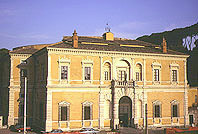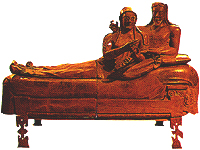Etruscan Museum of Villa Giulia
 (Museo Etrusco di Villa Giulia).This is a wonderful setting for the Etruscan Museum, especially since the Etruscans were as partial to banquets and parties as the Pope, who used this place for lavish entertainment.
(Museo Etrusco di Villa Giulia).This is a wonderful setting for the Etruscan Museum, especially since the Etruscans were as partial to banquets and parties as the Pope, who used this place for lavish entertainment.
The Etruscans were a mysterious people, whose language we still do not understand. Their way of life is well documented in their tomb paintings and we have gleaned some information from what was buried in their tombs. Yet we still know little about them.
9C - 4C BC they lived in an area between Florence and Rome - but did they come from further North? Or Asia Minor? It was their engineering skills which drained the Forum swamps.
They invented the Roman arch by inserting the "key stone" in the center.
Much more sophisticated than the early Roman shepherds, the latter were so dazzled by the Etruscans they chose them to be their Kings for 300 years.
Ground Floor: first rooms. Bronze copies of the round huts they lived in during their early period were used as containers for ashes of the dead.
These show how simply their startling culture began. In their tombs all their favorite utensils were buried with them for use in their next life - like the ancient Egyptians.
 Very soon you come upon the stars of the Museum; even more sensational than the jewelry, and the specialized instruments (doctors' scalpels, cooking tools, massaging utensils) are the lifelike and almost life-size Bride and Groom ("Sarcofago degli Sposi"). Made of terracotta which once had been highly painted, they are reclining happily on their own coffin, as if they were at a dinner party.
Very soon you come upon the stars of the Museum; even more sensational than the jewelry, and the specialized instruments (doctors' scalpels, cooking tools, massaging utensils) are the lifelike and almost life-size Bride and Groom ("Sarcofago degli Sposi"). Made of terracotta which once had been highly painted, they are reclining happily on their own coffin, as if they were at a dinner party.
They seem so in love, so young and beautiful. Was it life they were celebrating, or death? Were women equal with men, as they seem to be in sculptures like this, or were they deemed inferior?
Further on, don't miss the sculptures of Hercules and Apollo. They too are wonderfully expressive, and have that peculiar Etruscan look about the eyes.
There is a plethora of black vases with terracotta figures (leaving out the bodies and painting in the black background first), and terracotta vases with "black face" design (when the figures are painted black and the background is left clay-colored).
Most are from Greece and at that time were so highly prized by the Etruscans that they copied them! Then their own "buccari" pottery is very fine: extremely thin, black and shiny.
Sports were an important part of life in Etruria, and there are many objects celebrating this in the Museum. The sheer plethora of wonderful artifacts, in the end makes one too lazy to visit the upper floor.
In the garden, in addition to Papa Julio's Nympheum is a reconstructed Etruscan Temple: the end tiles that stand up like a frightened fringe are a handsome device to finish a roof, and at the corners are the high priestesses, peering out disapprovingly.
| Etruscan Museum of Villa Giulia History 1553. Architects Vignola and Ammannati. When Pope Julius III Ciocchi del Monte, (a compromise choice when the English Cardinal Reginald Pole lost by one vote!) had this splendid palace built it seemed bucolic and quite far out of town. |
Piazza Villa Giulia . (Beyond Map Area)
Open Tuesday through Saturday 9 am to 7 pm. Sunday and holidays 9 am to 2 pm. Closed Monday
Snack Bar. On summer evenings there are sometimes concerts in the garden.
Open Tuesday through Saturday 9 am to 7 pm. Sunday and holidays 9 am to 2 pm. Closed Monday
Snack Bar. On summer evenings there are sometimes concerts in the garden.